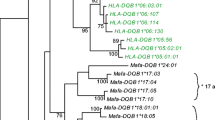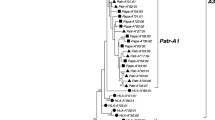Abstract
Little is known regarding the rates at which natural selection can modify or retain antigen presenting alleles at the major histocompatibility complex (MHC). Discovery of identical [1101 base pairs (bp)] coding regions at the MHC class I C locus in Pan troglodytes and Pan paniscus, chimpanzee species that diverged ∼2.3 million years ago, now indicates that a class I allotype can survive for at least this period. Remarkable conservation was also reflected in the (1799 bp) introns where a maximum of only six substitutions distinguished five alleles (three from P. troglodytes and two from P. paniscus) that encoded the identical heavy chain allotype. Analysis of a more distantly related human allele, HLA-Cw * 0702, corroborated that intron variation was non-uniform along the gene. Thus we provide a clear reference frame for the lifetime of an MHC class I allotype, a direct estimate of allelic substitution rates, and evidence for an unusual evolution of MHC class I introns.
Similar content being viewed by others
Author information
Authors and Affiliations
Additional information
Received: 13 August 1997
Rights and permissions
About this article
Cite this article
Cooper, S., Adams, E., Wells, R. et al. A major histocompatibility complex class I allele shared by two species of chimpanzee. Immunogenetics 47, 212–217 (1998). https://doi.org/10.1007/s002510050350
Issue Date:
DOI: https://doi.org/10.1007/s002510050350




